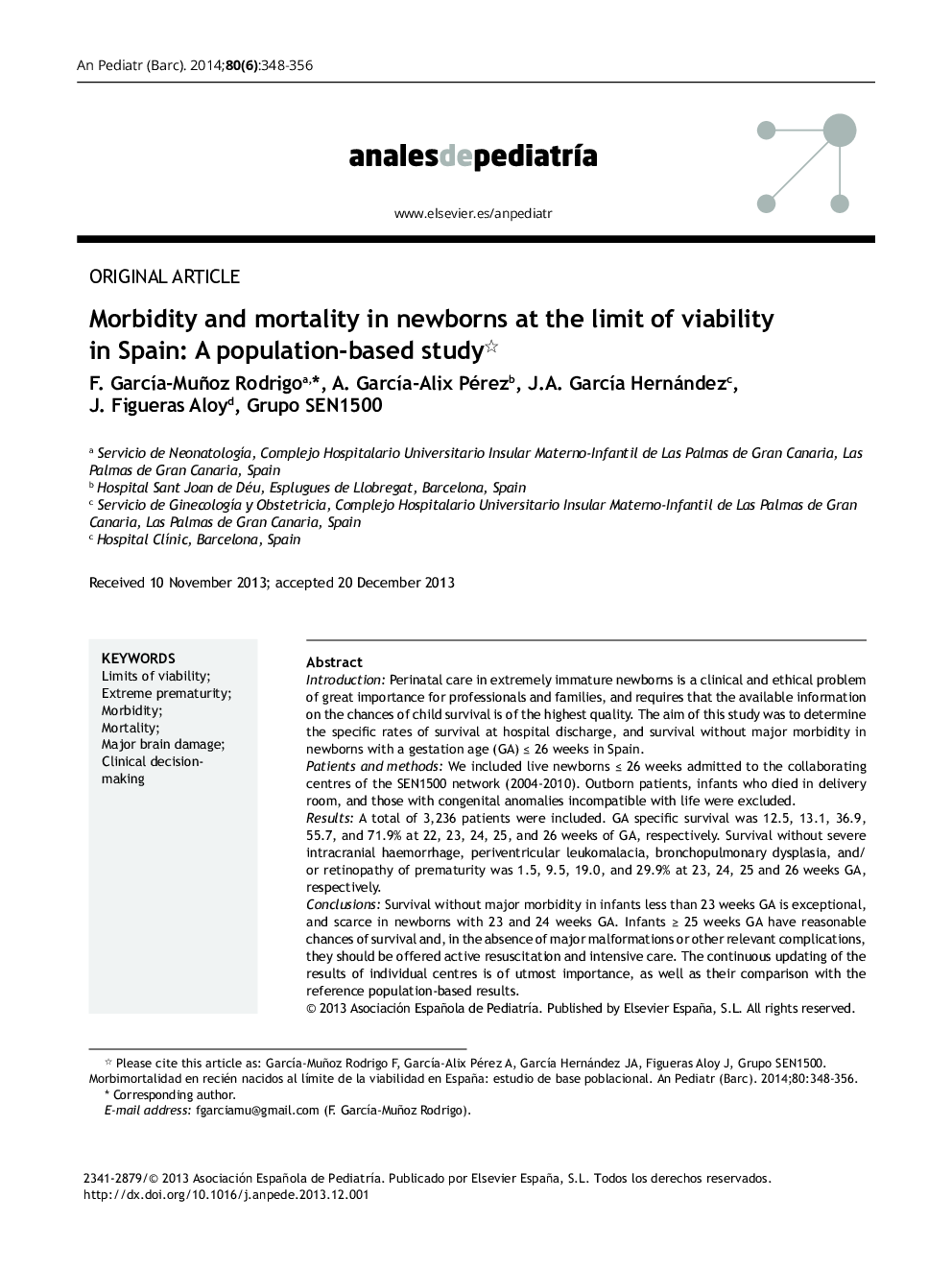| کد مقاله | کد نشریه | سال انتشار | مقاله انگلیسی | نسخه تمام متن |
|---|---|---|---|---|
| 4145237 | 1606771 | 2014 | 9 صفحه PDF | دانلود رایگان |
IntroductionPerinatal care in extremely immature newborns is a clinical and ethical problem of great importance for professionals and families, and requires that the available information on the chances of child survival is of the highest quality. The aim of this study was to determine the specific rates of survival at hospital discharge, and survival without major morbidity in newborns with a gestation age (GA) ≤ 26 weeks in Spain.Patients and methodsWe included live newborns ≤ 26 weeks admitted to the collaborating centres of the SEN1500 network (2004-2010). Outborn patients, infants who died in delivery room, and those with congenital anomalies incompatible with life were excluded.ResultsA total of 3,236 patients were included. GA specific survival was 12.5, 13.1, 36.9, 55.7, and 71.9% at 22, 23, 24, 25, and 26 weeks of GA, respectively. Survival without severe intracranial haemorrhage, periventricular leukomalacia, bronchopulmonary dysplasia, and/or retinopathy of prematurity was 1.5, 9.5, 19.0, and 29.9% at 23, 24, 25 and 26 weeks GA, respectively.ConclusionsSurvival without major morbidity in infants less than 23 weeks GA is exceptional, and scarce in newborns with 23 and 24 weeks GA. Infants ≥ 25 weeks GA have reasonable chances of survival and, in the absence of major malformations or other relevant complications, they should be offered active resuscitation and intensive care. The continuous updating of the results of individual centres is of utmost importance, as well as their comparison with the reference population-based results.
ResumenIntroducciónLa asistencia perinatal a recién nacidos (RN) extremadamente inmaduros constituye un problema clínico y ético de gran trascendencia para profesionales y familias, y hace necesaria una información actualizada de la máxima calidad acerca de las posibilidades de supervivencia del niño. El objetivo de este estudio fue conocer las tasas específicas de supervivencia al alta hospitalaria y de supervivencia sin morbilidad mayor conocida en RN con una edad gestacional (EG) ≤ 26 semanas en España.Pacientes y métodosSe incluyeron los RN vivos de ≤ 26 semanas que ingresaron en los centros colaboradores de la red SEN1500 (2004-2010). Se excluyeron los nacidos extramuros, los fallecidos en el paritorio y los que tenían malformaciones incompatibles con la vida.ResultadosEn total 3.236 pacientes fueron incluidos. La supervivencia específica por EG fue de 12,5, 13,1, 36,9, 55,7 y 71,9% a las 22, 23, 24, 25 y 26 semanas de EG, respectivamente. La supervivencia sin hemorragia intracraneal grave, leucomalacia periventricular, displasia broncopulmonar y/o retinopatía de la prematuridad fue del 1,5, 9,5, 19,0 y 29,9% a las 23, 24, 25 y 26 semanas, respectivamente.ConclusionesLa supervivencia sin morbilidad mayor en menores de 23 semanas de EG es excepcional, y en RN de 23 y 24 semanas, muy baja. Los RN ≥ 25 semanas de EG tienen posibilidades razonables de supervivencia y, en ausencia de malformaciones mayores u otras complicaciones relevantes, se les debería ofrecer reanimación activa y cuidados intensivos. Es fundamental la actualización continua de los datos propios de cada centro y su comparación con los resultados poblacionales de referencia.
Journal: Anales de Pediatría (English Edition) - Volume 80, Issue 6, June 2014, Pages 348-356
